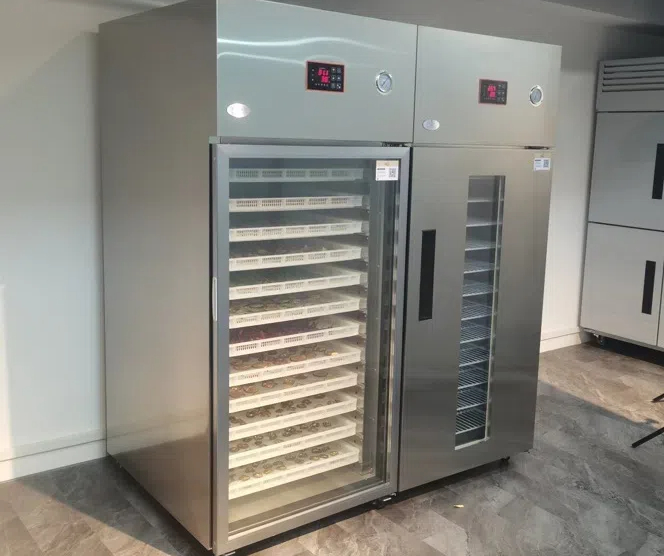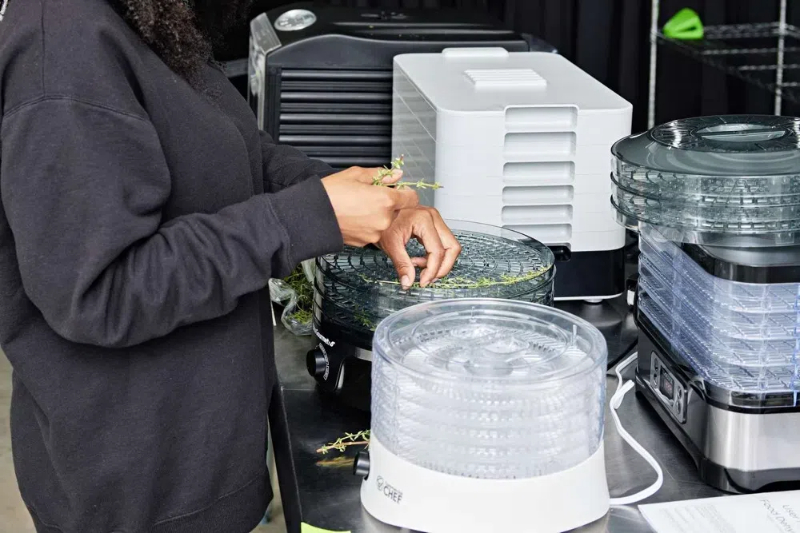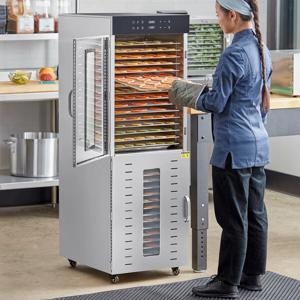
Content Menu
● Introduction
● What is a Cabinet Type Dehydrator Machine?
● Key Features and Benefits
● Types of Food Dehydrators
● Applications
● Components of a Cabinet Type Dehydrator Machine
● How Cabinet Type Dehydrators Work
● Advantages of Using Cabinet Type Dehydrators
● Factors to Consider When Choosing a Cabinet Type Dehydrator
● Maintenance Tips
● Cabinet Type Dehydrator Machine Supplier
● Conclusion
● FAQ
>> 1. What types of food can be dehydrated using a cabinet dehydrator?
>> 2. How do I ensure even drying in a cabinet dehydrator?
>> 3. What temperature should I use for dehydrating different foods?
>> 4. How long does it take to dehydrate food in a cabinet dehydrator?
>> 5. How do I store dehydrated food?
● Citations:
Introduction
As a premier food dehydrator machine production factory in China, we specialize in providing OEM services for a diverse clientele including international food dehydrator brands, wholesalers, and manufacturers. This comprehensive guide delves deep into the world of cabinet-type dehydrator machines, offering an in-depth exploration of their features, benefits, applications, and maintenance. Cabinet Type Dehydrator Machines are the cornerstone of efficient and reliable food preservation, providing a multi-functional solution designed to preserve and enhance the nutritional value of various food products. They are especially suited for small-to-medium-scale operations, capably handling capacities ranging from 100kg to 1000kg. Our commitment is to provide you with all the essential information to make informed decisions when sourcing or utilizing these invaluable machines.

What is a Cabinet Type Dehydrator Machine?
A cabinet type dehydrator machine is a self-contained unit meticulously engineered to eliminate moisture from food products, significantly extending their shelf life while preserving their natural flavors, vibrant colors, and essential nutrients. These machines are distinguished by their integrated design, seamlessly combining a heat pump dryer with a precisely controlled chamber to optimize performance and maximize energy efficiency. Unlike simpler dehydrators, cabinet models offer unparalleled consistency and control, making them a preferred choice for commercial applications and serious home users. The controlled environment ensures uniform drying, resulting in superior product quality and minimal waste.
Key Features and Benefits
-High Efficiency: Cabinet dehydrators offer efficient and consistent dehydration for a wide range of fresh products, ensuring minimal energy waste. This efficiency translates to lower operating costs and a more sustainable approach to food preservation.
-Capacity: Ideally suited for small-to-medium-scale operations, these machines can handle batches ranging from 100kg to 1000kg of products. This capacity makes them perfect for small businesses, farms, and food processing facilities seeking to expand their capabilities.
-Integrated Design: The seamless integration of the heat pump dryer with the chamber is a hallmark of cabinet dehydrators. This design optimizes performance and energy utilization, ensuring that the machine operates at peak efficiency.
-Portability: Thoughtfully designed for easy loading into standard shipping containers, our cabinet dehydrators can be quickly transported and immediately put into operation upon receipt. This portability is a significant advantage for businesses that need to move or expand their operations.
-Versatility: One of the most compelling features of cabinet dehydrators is their versatility. They are suitable for dehydrating a wide variety of products, including meat, fish, fruits, vegetables, herbs, flowers, noodles, pasta, and much more. This adaptability makes them an invaluable asset for diverse food processing applications.
-Precise Control: Cabinet dehydrators offer precise temperature and airflow control, ensuring even dehydration and preserving the integrity of textures and flavors. This level of control is essential for producing high-quality dehydrated products that meet the exacting standards of the food industry.
-Extended Shelf Life: By effectively removing moisture, cabinet dehydrators significantly increase the shelf life of food products. This extended shelf life reduces spoilage, minimizes waste, and allows for longer storage and distribution.
-Nutrient Preservation: Unlike some other preservation methods, cabinet dehydrators excel at preserving the natural flavors, colors, and nutrients in food. The controlled drying process minimizes degradation, ensuring that the dehydrated products retain their nutritional value.
-Waste Reduction: Cabinet dehydrators help farmers and producers convert seasonal harvests into all-season products, minimizing food waste. This capability is particularly important in addressing food security and promoting sustainable agricultural practices.
Types of Food Dehydrators
The market offers a range of food dehydrators, each designed to meet specific needs and applications. Understanding the different types can help you choose the best option for your operation:
1. Stackable Dehydrators: These dehydrators feature trays stacked vertically, with the heating element and fan located at the bottom or top. They are generally more budget-friendly and suitable for small kitchens or home use. However, they may require manual rotation of the trays to ensure even drying, as the temperature and airflow can vary depending on the tray's position.
2. Cabinet (Box-Type) Dehydrators: Cabinet dehydrators, also known as box-type dehydrators, are designed for larger-scale operations and offer superior control and consistency. These models feature a fully enclosed cabinet with trays that slide in and out, similar to an oven. The heating element and fan are typically located at the back of the cabinet, ensuring even heat distribution throughout the interior. Cabinet dehydrators are more expensive than stackable models but offer greater capacity, precision, and efficiency. They are ideal for commercial applications and serious home users who demand the best possible results.
Applications
Cabinet dehydrators are versatile tools with a wide range of applications across various industries:
-Food Processing: In the food processing industry, cabinet dehydrators are used to create a variety of dehydrated products, including dried fruits, vegetable chips, fruit leathers, and meat jerky. These products are popular snacks, ingredients, and emergency food supplies due to their long shelf life and portability.
-Agriculture: Farmers can use cabinet dehydrators to transform excess produce into value-added products, reducing waste and increasing their income. Dehydrated fruits and vegetables can be sold directly to consumers or used as ingredients in processed foods.
-Herbal Medicine: In herbal medicine, cabinet dehydrators facilitate the gentle drying of herbs, flowers, and roots, preserving their therapeutic properties. The controlled drying process ensures that the herbs retain their potency and effectiveness.
-Pet Food: Cabinet dehydrators are also used in the production of pet food, creating dehydrated treats and ingredients that are healthy and nutritious for animals.
-Research and Development: Researchers use cabinet dehydrators in laboratories to dry samples and materials for various experiments and analyses.
Components of a Cabinet Type Dehydrator Machine
A typical cabinet type dehydrator machine comprises several essential components that work together to achieve optimal drying results:
-Insulated Cabinet: The main structure of the dehydrator is an insulated cabinet, which helps maintain a consistent temperature inside the chamber. The insulation layer between the cabinet's outer shell and the inner chamber minimizes heat loss, improving energy efficiency and ensuring uniform drying.
-Heating Unit: The heating unit generates heat inside the cabinet, raising the temperature to the desired level for dehydration. This unit often includes heat pipes or electric coils, carefully selected to provide efficient and reliable heating.
-Cooling System: The cooling system is connected to the heating unit to manage and regulate the temperature inside the cabinet. This system prevents overheating and ensures that the temperature remains within the desired range throughout the drying process.
-Temperature and Humidity Controller: A sophisticated temperature and humidity controller monitors and adjusts the temperature and humidity levels inside the cabinet. This controller is essential for maintaining optimal drying conditions and preventing spoilage or uneven drying.
-Air Circulation System: The air circulation system includes fans and air ducts that ensure even distribution of heat throughout the cabinet. This system is crucial for removing moisture from the food and preventing hot spots or cold spots that could lead to uneven drying.
-Trays: Multiple trays are used to hold the food items during the dehydration process. These trays are typically made from stainless steel or food-grade plastic and are designed to allow for maximum airflow around the food.
-Control Panel: A user-friendly control panel allows the operator to set and monitor the dehydration process. This panel typically includes a digital display, temperature and humidity controls, and a timer.

How Cabinet Type Dehydrators Work
1. Loading: Food items are carefully placed on the trays inside the cabinet, ensuring that they are evenly spaced to allow for optimal airflow.
2. Heating: The heating unit raises the temperature inside the cabinet to the desired level, typically between 130°F and 165°F, depending on the type of food being dehydrated.
3. Air Circulation: The air circulation system kicks in, circulating warm air throughout the cabinet and removing moisture from the food.
4. Moisture Removal: As the air absorbs moisture from the food, it is vented out of the cabinet, preventing condensation and maintaining a dry environment.
5. Monitoring and Control: The temperature and humidity controller continuously monitors the conditions inside the cabinet, making adjustments as needed to maintain optimal drying conditions.
Advantages of Using Cabinet Type Dehydrators
-Consistent Drying: Ensures uniform dehydration due to controlled temperature and airflow, resulting in consistent product quality.
-Energy Efficiency: Optimizes energy use by integrating a heat pump dryer and minimizing heat loss through insulation.
-Large Capacity: Suitable for processing significant quantities of food, making it ideal for commercial operations.
-Versatility: Can be used for various types of food products, from fruits and vegetables to meats and herbs.
-User-Friendly: Simple to operate and requires minimal setup, allowing for efficient and hassle-free operation.
Factors to Consider When Choosing a Cabinet Type Dehydrator
-Capacity: Determine the volume of food you need to dehydrate per batch and choose a model with sufficient tray space.
-Temperature Range: Ensure the dehydrator can reach the temperatures required for different types of food, with adjustable settings for optimal results.
-Airflow System: Look for a system that provides even air distribution throughout the cabinet, preventing hot spots and ensuring uniform drying.
-Material Quality: Choose machines made from durable, food-grade materials such as stainless steel, which are easy to clean and resistant to corrosion.
-Energy Efficiency: Consider the energy consumption of the dehydrator to minimize operating costs and reduce your environmental impact.
-Ease of Cleaning: Opt for models with removable, dishwasher-safe parts for easy cleaning and maintenance.
-Control Features: Advanced models offer precise control over temperature and humidity, allowing you to fine-tune the drying process for optimal results.
-Size and Portability: Depending on your factory layout, consider the size and portability for ease of integration and movement.
Maintenance Tips
-Regular Cleaning: Clean the trays and interior after each use to prevent buildup of food particles and bacteria.
-Check Airflow: Ensure the air vents are not blocked to maintain proper circulation and prevent overheating.
-Inspect Heating Elements: Periodically check the heating elements for any damage or corrosion.
-Monitor Temperature Controls: Calibrate the temperature controller to ensure accurate readings and prevent uneven drying.
-Follow Manufacturer's Instructions: Adhere to the manufacturer's guidelines for optimal performance and longevity.
Cabinet Type Dehydrator Machine Supplier
As a trusted Cabinet Type Dehydrator Machine Supplier, we cater to a diverse array of industries, including but not limited to food processing, where our machines excel in dehydrating meat, fish, fruits, vegetables, herbs, flowers, leaves, noodles, pasta, and much more. We pride ourselves on delivering reliable, high-performance machines that meet the exacting standards of our clients.
Conclusion
Cabinet Type Dehydrator Machines are indispensable for modern food processing, offering unparalleled efficiency, versatility, and precise control. As a leading OEM supplier, our machines are meticulously engineered to meet the diverse requirements of the food industry, ensuring top-quality dehydration solutions for our valued clients. By choosing our Cabinet Type Dehydrator Machines, you're investing in a future of streamlined operations, superior product quality, and enhanced sustainability.

FAQ
1. What types of food can be dehydrated using a cabinet dehydrator?
Cabinet dehydrators are versatile and can dry a wide range of foods, including fruits, vegetables, meats, herbs, and spices. This versatility makes them an essential tool for any food processing operation.
2. How do I ensure even drying in a cabinet dehydrator?
To ensure even drying, make sure that the dehydrator has a good airflow system and that food is spread evenly on the trays. Avoid overcrowding, which can block airflow and lead to uneven drying.
3. What temperature should I use for dehydrating different foods?
Different foods require different temperatures. Generally, fruits and vegetables are dried at lower temperatures (130-140°F), while meats require higher temperatures (155-165°F) to prevent bacterial growth.
4. How long does it take to dehydrate food in a cabinet dehydrator?
Drying times vary depending on the type of food, thickness, and moisture content. It can take anywhere from 4 to 24 hours, so it's essential to monitor the food closely during the process.
5. How do I store dehydrated food?
Store dehydrated food in airtight containers in a cool, dark, and dry place. Properly stored dehydrated food can last for several months to a year, making it a convenient and long-lasting food preservation method.
Citations:
[1] https://www.dryeratech.com/cabinet-type-dehydrator-machine.html
[2] https://patents.google.com/patent/CN110207480A/zh
[3] https://www.seriouseats.com/best-food-dehydrators-5216308
[4] https://patents.google.com/patent/CN1110593C/zh
[5] https://aradmachineryco.com/article/Food-dehydrator-buying-guide
[6] https://www.whirlpool.com.hk/media/wysiwyg/Downloads/WWPR64210_user_manual_program_chart_EN_CN.pdf
[7] https://www.lowes.com/n/buying-guide/best-food-dehydrator-buying-guide
[8] https://patents.google.com/patent/CN1405396A/zh











